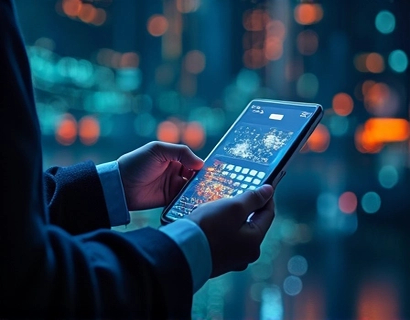Exploring the Frontier of Accessibility and Productivity: A Deep Dive into Universal App Innovations
The landscape of technology is rapidly evolving, with a growing emphasis on inclusivity and accessibility. At the forefront of this movement is a platform dedicated to showcasing a diverse array of applications that bridge the gap between technology and everyday life, ensuring that innovation is within reach for all users. This comprehensive exploration delves into the world of universal applications, highlighting how these tools are transforming productivity, creativity, and accessibility.
Understanding Universal Applications
Universal applications are designed to be accessible and functional for a wide range of users, including those with disabilities. These apps leverage advanced technologies such as voice commands, haptic feedback, and adaptive interfaces to create an inclusive user experience. The goal is to ensure that everyone, regardless of their abilities, can benefit from the latest technological advancements.
The concept of universal design in technology is not new, but the recent surge in innovation has led to the development of apps that are more intuitive, user-friendly, and versatile than ever before. These applications are not just tools for individuals with disabilities; they enhance the lives of all users by simplifying complex tasks and providing new ways to interact with digital content.
Enhancing Productivity Through Universal Design
One of the most significant impacts of universal applications is in the realm of productivity. For professionals and students alike, these tools can streamline workflows, increase efficiency, and reduce the learning curve associated with new technologies. Here are some ways in which universal apps are revolutionizing productivity:
- Voice-Activated Task Management: Apps that use voice recognition to create and manage to-do lists, set reminders, and dictate notes are making it easier for users to stay organized without the need for manual input. This is particularly beneficial for those with mobility or dexterity challenges.
- Adaptive Text Editing: Universal text editors that offer features like speech-to-text, text-to-speech, and customizable font sizes and colors are transforming the way users create and edit content. These tools help individuals with visual impairments or dyslexia to write and read more effectively.
- Smart Calendar Integration: Calendar apps that integrate with other productivity tools and can be controlled via voice commands or gestures are simplifying scheduling and time management. Users can add events, set alarms, and receive notifications hands-free, making it easier to stay on top of their schedules.
Fostering Creativity with Accessible Tools
Creativity knows no bounds, and universal applications are opening new avenues for artistic expression and content creation. These tools are designed to be accessible, allowing artists, writers, and creators of all abilities to bring their ideas to life.
Consider the following examples:
- Visual Art Tools: Drawing and painting apps that support touch, voice commands, and eye-tracking technology are enabling artists with physical disabilities to create stunning digital art. These apps often include features like customizable brush sizes, color palettes, and undo functions, making the creative process more intuitive.
- Music Composition Software: Music apps that use gesture control, voice commands, and adaptive keyboards are making it possible for musicians with varying levels of ability to compose and perform music. These tools can transform the way users interact with musical interfaces, breaking down barriers to entry.
- Writing Assistance Tools: Writing apps that offer real-time suggestions, grammar checks, and speech-to-text capabilities are empowering writers to produce high-quality content more efficiently. These tools are especially useful for individuals with writing disabilities or those who prefer dictation over typing.
Improving Accessibility in Everyday Life
Beyond productivity and creativity, universal applications are making a significant impact on daily life, enhancing accessibility in various contexts. Here are some ways these tools are changing the game:
- Smart Home Integration: Apps that control smart home devices through voice commands or simple gestures are improving the independence of users with mobility impairments. From adjusting lighting and temperature to managing security systems, these apps make it easier to create a comfortable and safe living environment.
- Navigation and Transportation: Navigation apps that provide audio descriptions, tactile feedback, and customizable routes are making travel more accessible. These tools help users with visual impairments or cognitive disabilities to navigate unfamiliar areas with confidence.
- Health and Wellness Apps: Health apps that offer voice-guided exercises, medication reminders, and mental health resources are supporting users in maintaining their well-being. These applications can be particularly beneficial for individuals with chronic conditions or those who require regular health monitoring.
The Role of Innovation in Universal App Development
Innovation plays a crucial role in the development of universal applications. Advances in artificial intelligence, machine learning, and sensor technology are driving the creation of more sophisticated and user-friendly tools. Here are some key areas where innovation is making a difference:
Firstly, AI and Machine Learning are enabling apps to learn from user behavior and adapt to individual needs. For example, a note-taking app might recognize a user's handwriting patterns and adjust the input sensitivity accordingly, or a productivity app could predict and suggest tasks based on past activities.
Secondly, Sensor Technology is enhancing the interactivity and responsiveness of universal apps. Devices equipped with cameras, microphones, and haptic feedback can provide a richer user experience, allowing for more natural and intuitive interactions. For instance, a photo editing app could use the device's camera to preview edits in real-time, or a gaming app could use haptic feedback to simulate tactile sensations.
Lastly, Collaborative Development is fostering a community-driven approach to creating universal applications. Developers, designers, and accessibility experts are working together to ensure that apps meet the diverse needs of users. This collaborative effort leads to more robust and inclusive solutions that can be widely adopted.
Exploring the Platform: A Journey Through Diversity
The platform that serves as a showcase for these innovative universal applications is a testament to the diversity and potential of modern technology. As users navigate through the various categories and apps, they encounter a wide range of solutions tailored to different needs and preferences.
One section might feature apps focused oneducation, offering tools for students with learning disabilities, such as reading aids and interactive lesson planners. Another section could highlightemployment apps that assist job seekers with disabilities in finding and applying for positions, including resume builders and interview preparation guides.
The platform also includes apps forpersonal assistance, providing tools for managing daily tasks, setting reminders, and accessing information hands-free. These apps are designed to empower users to lead more independent lives, enhancing their quality of life and fostering a sense of autonomy.
Conclusion: Embracing a Future of Inclusive Innovation
The exploration of universal applications reveals a promising future where technology is not only powerful but also inclusive. By prioritizing accessibility and creativity, developers are creating tools that break down barriers and open up new possibilities for all users. As innovation continues to advance, the potential for even more transformative applications is vast.
It is essential for tech enthusiasts, innovators, and anyone interested in the intersection of technology and society to stay informed about these developments. By supporting and utilizing universal applications, we can contribute to a more inclusive and equitable world, where everyone has the opportunity to thrive.











































